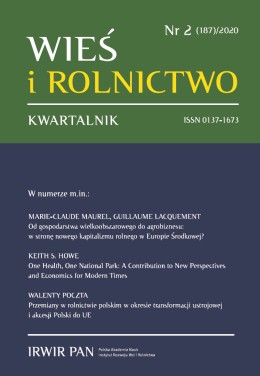One Health, One National Park: A Contribution to New Perspectives and Economics for Modern Times
DOI:
https://doi.org/10.53098/wir022020/02Keywords:
One Health, systems, risk, mitigation resources, Lyme disease, Alabama rot, strangles, bovine tuberculosis, New Forest National Park, EnglandAbstract
One Health is a concept that sees human, animal, and environmental health as parts of a single interdependent system. The Covid-19 pandemic, its implications reaching far beyond the direct effects of a coronavirus on people’s health, underlines the importance of this increasingly influential perspective. In practice, One Health has its roots in early affiliations of human and animal health science. Over time, each sphere of inquiry evolved to address its own agenda. Recently, veterinary scientists have led the reintegration, extension, and promotion of One Health sciences to address modern-day problems in which health and people’s general wellbeing are viewed as inseparable. A prerequisite is to set out a framework of concepts and principles enabling clear definition of problems, interrelationships needing to be understood, and the level of aggregation appropriate for quantitative analysis. This paper extends the framework by considering economic trade-offs that inevitably must be made in the human, animal, and environmental sub-systems, and the consequences when policy interventions are superimposed on them. The New Forest National Park in southern England is a case where this perspective is essential. Following the Stone Mountain definition of One Health, first a conventional approach linking human and animal health is taken. Lyme disease, Alabama rot, bovine tuberculosis and strangles are examples of diseases known to be of significant concern. The focus is finding scope for socially efficient risk reduction in response to mitigation resource use. Superimposed on the grazing livestock subsystems are support payments for commoner farmers. The financial incentives provided by what effectively are headage payments have caused animal inventories to grow so much that the wider environment may well be subject to adverse spillover effects that merit investigation.
References
Animal & Plant Health Agency (2019). Year End Descriptive Epidemiology Report: Bovine TB Epidemic in the England Edge Area. Delivery Area: Southern, Name of County: Hampshire. Year-end report for: 2018. TR398 (Rev. 08/19) Department for Environment, Food and Rural Affairs
Baumeister R.F., Bratslavsky E., Finkenauer C., Vohs K.D. (2001). Bad is stronger than good. Review of General Psychology, 5, 323–370. DOI: https://doi.org/10.1037/1089-2680.5.4.323
Buchan K., Collins F. (2020). The Tree Surgery. Broadleaf, the Woodland Trust, No 101, Summer, 19–23.
Cumming D.H.M., Cumming G.S. (2015). One Health: an Ecological and Conservation Perspective. In Zinsstag et al. (op. cit.) Chapter 4, 38–52. DOI: https://doi.org/10.1079/9781780643410.0038
Deem S.L., Lane-deGraaf K.E., Rayhel E.A. (2019). Introduction to One Health: An Interdisciplinary Approach to Planetary Health. Wiley-Blackwell.
Dixon M.A., Dar O.A., Heymann D.L. (2014). Emerging infectious diseases: opportunities at the human-animal-environment interface. Veterinary Record, 174 (22), 546–551. DOI: https://doi.org/10.1136/vr.g3263
Drummond M.F., Sculpher M.J., Claxton K., Stoddart G.L., Torrance G.W. (2015). Methods for the Economic Evaluation of Health Care Programmes. Fourth edition. Oxford: Oxford University Press.
Environment Act (1995), http://www.legislation.gov.uk/ukpga/1995/25/contents (accessed: June 2020).
Gibbs E.P.J. (2014). The evolution of One Health: a decade of progress and challenges for the future. Veterinary Record, 174 (4), 85–91. DOI: https://doi.org/10.1136/vr.g143
Glover J. (2019). Landscapes Review: Final report, Chapter 3. https://www.gov.uk/government/publications/designated-landscapes-national-parks-and-aonb (accessed: June 2020).
Godfray C., Donnelly C., Hewinson G., Winter M., Wood J. (2018). Bovine TB Strategy Review. Report to Rt Hon Michael Gove MP, Secretary of State, Defra. October.
Harrison S., Kivuti-Bitok L., Macmillan A., Priest P. (2019). EcoHealth and One Health: A theory-focused review in response to calls for convergence. Environment Internation al, 132, 105058. DOI: https://doi.org/10.1016/j.envint.2019.105058
HM Government (2018). A Green Future: Our 25 Year Plan to Improve the Environment. https://assets.publishing.service.gov.uk/government/uploads/system/uploads/attachmet_data/file/693158/25-year-environment-plan.pdf (accessed: June 2020).
Howe K.S. (2018). Contesting the Commons: Economics and Politics in the New Forest National Park of Southern England. Wieś i Rolnictwo, 179 (2), 85–112. DOI: https://doi.org/10.53098/wir022018/05
Independent Scientific Group on Cattle TB (2007). Bovine TB: The Scientific Evidence. Final Report.
Kahneman D., Tversky A. (1979). Prospect theory: An analysis of decision under risk. Econometrica, 47, 263–291. DOI: https://doi.org/10.2307/1914185
King Sir D. (2007). Bovine Tuberculosis in Cattle and Badgers. A Report by the Chief Scientific Adviser to the Secretary of State, Department of the Environment, Food, and Rural Affairs.
McGraw A.P., Larsen J.T., Kahneman D., Schkade D. (2010). Comparing gains and losses. Psychological Science, 21, 1438–1445. DOI: https://doi.org/10.1177/0956797610381504
National Parks and Access to the Countryside Act 1949. http://www.legislation.gov.uk/ukpga/1949/97/pdfs/ukpga_19490097_en.pdf (accessed: June 2020).
Oura C. (2014). A One Health approach to the control of zoonotic vector-borne pathogens. Veterinary Record, 174 (16), 398–402 DOI: https://doi.org/10.1136/vr.g2539
Public Health England and National Parks England (2017). An Accord between National Parks and Public Health England to support joint action on improving health and well-being through our national parks. September, 6 pages.
RJS Associates Ltd. (2018). New Forest Recreation and Leisure Visits. Report commissioned by the New Forest National Park Authority on behalf of the Recreation Strategy Steering Group. October.
RSPB (Royal Society for the Protection of Birds) (2020). Recovering Together: A report of public opinion on the role and importance of nature during and in our recovery from the Coronavirus crisis in England. June. https://www.rspb.org.uk/globalassets/downloads/recovering-together-report/ (accessed: June 2020).
Rüegg S.R., Häsler B., Zinsstag J. (2018). Integrated Approaches to Health: A Handbook for the Evaluation of One Health. Wageningen Academic Publishers. DOI: https://doi.org/10.3920/978-90-8686-875-9
Stringer A. (2014). Improving animal health for poverty alleviation and sustainable livelihoods. Veterinary Record, 175 (3), 526–529. DOI: https://doi.org/10.1136/vr.g6281
Woods A.M., Bresalier M. (2014). One health, many histories. Veterinary Record, 174 (26), 650–665. DOI: https://doi.org/10.1136/vr.g3678
Woods A., Bresalier M., Cassidy A., Dentinger R.M. (2018). Animals and the Shaping of Modern Medicine: One Health and its Histories. Medicine and Biomedical Sciences in Modern History. Palgrave Macmillan. DOI: https://doi.org/10.1007/978-3-319-64337-3
Yechiam E., Hochman G. (2013). Losses as modulators of attention: Review and analysis of the unique effects of losses over gains. Psychological Bulletin, 139, 497–518. DOI: https://doi.org/10.1037/a0029383
Zinsstag J., Schelling E., Waltner-Toews D., Whittaker M., Tanner M. (2015). One Health: The Theory and Practice of Integrated Health Approaches. CABI International. DOI: https://doi.org/10.1079/9781780643410.0000











